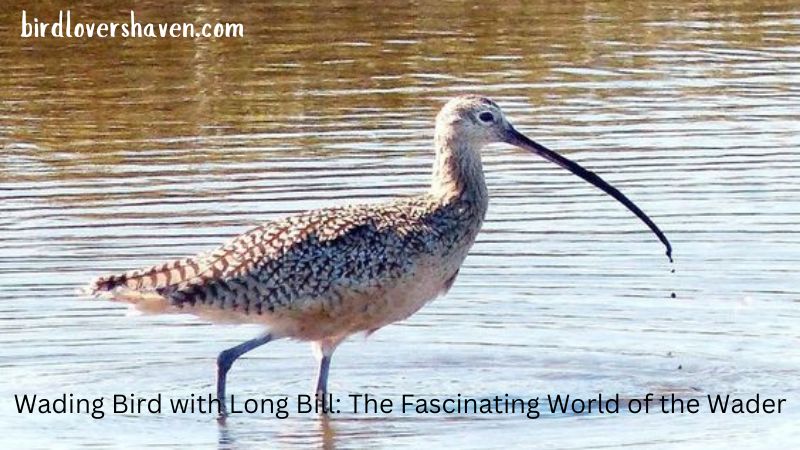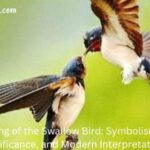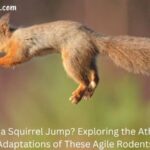Bird Species & Identification
Wading Bird with Long Bill: The Fascinating World of the Wader Hot 2024
Wading birds are a fascinating group of avian species known for their long legs, specialized feeding behaviors, and, often, their long bills. These birds are commonly found in wetland environments such as marshes, swamps, and shorelines, where their unique physical characteristics allow them to thrive.
The long bill, in particular, is a distinctive feature that has evolved in various ways to suit different feeding strategies and ecological niches. This article birdlovershaven.com delves into the world of wading bird with long bills, exploring their adaptations, behaviors, and the crucial roles they play in their ecosystems.
Table of contents
ToggleIdentifying Wading Bird with Long Bills
General Characteristics
Wading birds are generally characterized by their long legs, which enable them to navigate shallow waters, and their long bills, which vary in shape and size depending on their diet and feeding techniques. These bills can be straight, curved, or even spoon-shaped, and are often used to probe into the mud or sand, catch fish, or extract invertebrates from the water.
The length and shape of a wading bird’s bill are closely related to its feeding habits and the type of prey it consumes. For example, birds with long, slender bills may be adapted to catching small fish or probing deep into the mud for hidden invertebrates, while those with broad, flat bills might sift through the water or mud for tiny aquatic organisms.
Notable Species
Several species of wading bird with long bills are well-known and widely distributed across the globe. Some of the most prominent include:
- Great Egret (Ardea alba)
- American Avocet (Recurvirostra americana)
- Ibis species (e.g., White Ibis (Eudocimus albus), Glossy Ibis (Plegadis falcinellus))
- Long-billed Curlew (Numenius americanus)
- Roseate Spoonbill (Platalea ajaja)
Each of these species has unique characteristics and adaptations that make them well-suited to their specific environments.
Great Egret: A Graceful Hunter
Identification and Physical Characteristics
The Great Egret is one of the most iconic wading birds, easily recognizable by its tall stature, elegant white plumage, and long, sharp yellow bill. This bill is straight and pointed, ideal for spearing fish, frogs, and other small aquatic animals. The Great Egret’s long neck and legs give it a commanding presence in wetlands, where it is often seen standing still or moving slowly through shallow waters.
Habitat and Distribution
Great Egrets are found in a wide range of wetland habitats, including marshes, swamps, rivers, and coastal regions. They have a broad distribution, occurring across North America, Europe, Asia, and Africa. These birds are highly adaptable and can thrive in both freshwater and saltwater environments.
Feeding Behavior and Diet
The Great Egret uses its long bill to hunt by sight, typically standing still in the water or slowly stalking its prey. When it spots a fish or other small animal, it strikes quickly, using its bill like a spear to capture its meal. This hunting technique requires patience and precision, and the bird’s long bill is perfectly adapted for this purpose.
In addition to fish, Great Egrets also consume amphibians, reptiles, insects, and occasionally small mammals. Their diet is diverse, allowing them to exploit a variety of food sources depending on availability and seasonal changes.
Breeding and Nesting
During the breeding season, Great Egrets develop long, ornamental plumes on their backs, which are used in courtship displays. These birds nest in colonies, often with other wading bird species, building large, platform-like nests in trees or shrubs near water. The female typically lays three to five eggs, which both parents take turns incubating.
The long bill of the Great Egret plays a crucial role not only in feeding but also in nest-building, as the birds use it to gather sticks and other materials for their nests.
American Avocet: The Elegant Sifter
Identification and Physical Characteristics
The American Avocet is a striking wading bird known for its distinctive upturned bill and bold black-and-white plumage. The bird’s long, slender bill curves upward at the tip, making it an excellent tool for sweeping through the water to catch small invertebrates. This bill shape is unique among wading birds and is a key identifying feature of the species.
Habitat and Distribution
American Avocets are primarily found in shallow wetlands, including salt ponds, mudflats, and coastal lagoons. They breed in the interior regions of North America but migrate to coastal areas for the winter. Their preference for shallow water habitats makes them highly dependent on the availability of these environments, which are often threatened by human activity.
Feeding Behavior and Diet
The American Avocet’s feeding technique is known as “scything,” in which the bird sweeps its long, upturned bill from side to side through the water while walking. This motion allows the bird to catch small crustaceans, insects, and other invertebrates that are stirred up from the mud or water. The sensitivity of the bill’s tip helps the bird detect prey, even in murky conditions.
This unique feeding behavior distinguishes the American Avocet from other wading birds and highlights the specialization of its bill for this particular method of foraging.
Breeding and Nesting
American Avocets nest on the ground, typically on sandy or muddy shores near water. The female lays three to four eggs, which are incubated by both parents. The chicks are precocial, meaning they are able to walk and feed themselves shortly after hatching, though they remain under the protection of their parents for several weeks.
The upturned bill of the American Avocet is an adaptation that not only defines its feeding strategy but also plays a role in nest defense, as the birds will aggressively protect their nesting sites from intruders.
Ibis Species: Masters of Mud Probing
Identification and Physical Characteristics
Ibis species are easily recognized by their long, curved bills, which are perfectly adapted for probing into the mud and soft soil in search of food. The White Ibis, for example, has a long, slender bill that curves downward, while the Glossy Ibis has a similar but slightly more robust bill. These birds are typically medium to large in size, with long legs and a graceful, curved neck.
Habitat and Distribution
Ibises are found in wetlands across the world, from the marshes and swamps of North and South America to the riverbanks and rice paddies of Asia and Africa. They are highly adaptable birds, capable of living in both freshwater and brackish environments, and are often seen in large flocks, especially during migration.
Feeding Behavior and Diet
The long, curved bills of ibis species are specialized tools for their feeding habits. These birds feed primarily by probing into the soft mud and soil in search of invertebrates, such as insects, crustaceans, and worms. The sensitive tips of their bills allow them to detect prey hidden below the surface, which they then extract with a quick, precise movement.
In addition to invertebrates, some ibis species also eat small fish, amphibians, and even seeds, depending on what is available in their environment. Their feeding strategy is highly efficient, allowing them to exploit a wide range of food sources in their wetland habitats.
Breeding and Nesting
Ibises typically nest in colonies, often in trees or shrubs near water. They build large, stick nests where the female lays two to four eggs. Both parents share in the incubation and feeding of the chicks, which fledge after several weeks.
The long bill of the ibis is not only a key adaptation for feeding but also plays a role in social interactions and courtship displays, where the birds may use their bills to touch or preen each other as part of pair bonding.

Long-Billed Curlew: The Sandpiper of the Plains
Identification and Physical Characteristics
The Long-billed Curlew is the largest shorebird in North America, known for its extraordinarily long, decurved bill, which can measure up to eight inches in length. This bird’s bill is slender and curved downward, perfectly designed for reaching deep into the sand and mud to extract prey. The curlew’s plumage is a mottled brown and buff, providing excellent camouflage in its grassland and wetland habitats.
Habitat and Distribution
Long-billed Curlews breed in the grasslands of the western United States and Canada but migrate to coastal areas and interior wetlands for the winter. They are typically found in open habitats, such as prairies, marshes, and mudflats, where their long legs and bills allow them to forage effectively.
Feeding Behavior and Diet
The Long-billed Curlew’s feeding strategy is highly specialized. The bird uses its long bill to probe deep into the sand and mud, reaching invertebrates such as worms, crustaceans, and small mollusks that are buried out of reach for other birds. This probing behavior is facilitated by the bird’s long legs, which allow it to wade through deeper water and access food that other shorebirds cannot.
In addition to probing, Long-billed Curlews may also pick insects and other small animals from the surface of the ground. Their diet varies seasonally and includes grasshoppers, beetles, and other insects during the breeding season, as well as marine invertebrates during the winter.
Breeding and Nesting
Long-billed Curlews nest on the ground, typically in open grasslands where they create a simple scrape in the soil lined with grass and other vegetation. The female lays four eggs, which both parents incubate. The chicks are precocial, like those of the American Avoc
Breeding and Nesting (Continued)
The chicks of the Long-billed Curlew are precocial, meaning they are capable of walking and feeding themselves shortly after hatching. Despite this early independence, they remain under the care and protection of their parents for several weeks. The parents use their long bills to guide the chicks to food and to defend them from potential predators.
The choice of nesting sites in open grasslands or prairies is critical for the survival of the species, as these areas provide both the camouflage needed to protect the eggs and chicks and the food resources necessary for the parents to sustain themselves and their young.
Roseate Spoonbill: The Unique Filter Feeder
Identification and Physical Characteristics
The Roseate Spoonbill is a striking wading bird known for its bright pink plumage and its distinctive spoon-shaped bill. Unlike other wading birds with long, straight or curved bills, the spoonbill’s bill broadens and flattens at the tip, resembling a spoon. This unique bill shape is perfectly adapted for the bird’s filter-feeding behavior, allowing it to sift through the water for small aquatic prey.
Habitat and Distribution
Roseate Spoonbills are primarily found in the coastal wetlands of the southeastern United States, Central and South America, and the Caribbean. They inhabit estuaries, mangroves, and shallow lagoons, where their specialized feeding techniques can be effectively employed. The bright pink coloration of the Roseate Spoonbill is due to the carotenoid pigments in their diet, which consists largely of crustaceans and other invertebrates.
Feeding Behavior and Diet
The Roseate Spoonbill’s feeding behavior is distinct from other wading birds. It uses its long, spoon-shaped bill to sweep through the shallow water from side to side. As the bird moves its bill through the water, it detects and traps small fish, shrimp, and other aquatic organisms. The sensitive, flattened tip of the bill helps the spoonbill feel for prey in the murky water.
This method of feeding, known as “tactile foraging,” relies on touch rather than sight, making it effective even in turbid or dark waters. The Roseate Spoonbill’s diet is diverse and includes small fish, crustaceans, and insects, all of which contribute to the bird’s vibrant coloration.
Breeding and Nesting
Roseate Spoonbills nest in colonies, often alongside other wading birds such as egrets and herons. They build their nests in trees or shrubs near water, using sticks and other plant material. The female typically lays two to three eggs, which are incubated by both parents.
The spoonbill’s long, broad bill plays a role in nest-building, as the birds use it to gather and arrange sticks and other materials. The chicks hatch with straight bills that gradually develop their characteristic spoon shape as they grow.
Ecological Significance of Wading Bird with Long Bills
Role in Ecosystems
Wading bird with long bills play crucial roles in their ecosystems, particularly in wetland environments. As predators, they help control populations of fish, invertebrates, and other small aquatic organisms, maintaining a balance in the food web. Their feeding activities also contribute to the health of wetland ecosystems by promoting nutrient cycling and aerating the soil.
These birds are also important indicators of environmental health. Changes in the populations of wading birds can signal shifts in the availability of food resources, the quality of water, and the overall condition of wetland habitats. As wetlands are highly sensitive to environmental changes, monitoring wading bird populations provides valuable insights into the impacts of climate change, pollution, and habitat loss.
Seed Dispersal and Habitat Formation
In addition to their roles as predators, some wading bird with long bills, such as ibises, contribute to seed dispersal. As they move through wetlands and feed on fruits or seeds, they inadvertently disperse plant seeds through their droppings, facilitating plant growth and contributing to the formation of diverse plant communities.
Furthermore, the physical activities of wading birds, such as probing and foraging in the mud, can influence the structure of wetland habitats. By disturbing the soil and water, these birds help create microhabitats that support a variety of other organisms, from small invertebrates to plant species that thrive in disturbed environments.
Conservation Challenges and Efforts
Threats to Survival
Despite their ecological importance, wading bird with long bills face numerous threats, primarily due to human activities. Habitat loss is one of the most significant challenges, as wetlands are drained or altered for agriculture, urban development, and infrastructure projects. These changes reduce the availability of suitable feeding and nesting sites for wading birds.
Pollution, particularly from agricultural runoff, can also degrade wetland habitats, contaminating the water and reducing the abundance of prey species. Climate change poses an additional threat by altering weather patterns, water levels, and the distribution of wetlands, which can affect the birds’ migration routes and breeding success.
Illegal hunting and the pet trade also threaten certain species, particularly those with distinctive appearances or valuable feathers. The loss of these birds not only impacts their populations but also disrupts the ecological balance of the habitats they inhabit.
Conservation Initiatives
Conservation efforts aimed at protecting wading bird with long bills focus on habitat preservation, legal protections, and public education. Protecting and restoring wetlands is critical for maintaining healthy populations of these birds. This includes the establishment of protected areas, the restoration of degraded wetlands, and the implementation of sustainable land-use practices that minimize the impact on these crucial habitats.
International agreements, such as the Ramsar Convention on Wetlands, play a key role in the global effort to conserve wetland habitats and the species that depend on them. In addition, many countries have enacted laws to protect wading birds from hunting and trade, and to regulate the use of wetlands for agriculture and development.
Public education and awareness campaigns are also essential components of conservation efforts. By raising awareness about the importance of wading birds and their habitats, conservation organizations can encourage community involvement in protecting these species and promoting sustainable practices.
Conclusion
Wading bird with long bills are among the most specialized and ecologically significant avian species. Their unique physical adaptations, such as long legs and specialized bills, enable them to thrive in wetland environments and fulfill important ecological roles. From the Great Egret’s precision hunting to the American Avocet’s unique scything behavior, these birds demonstrate the incredible diversity and complexity of life in wetland ecosystems.





